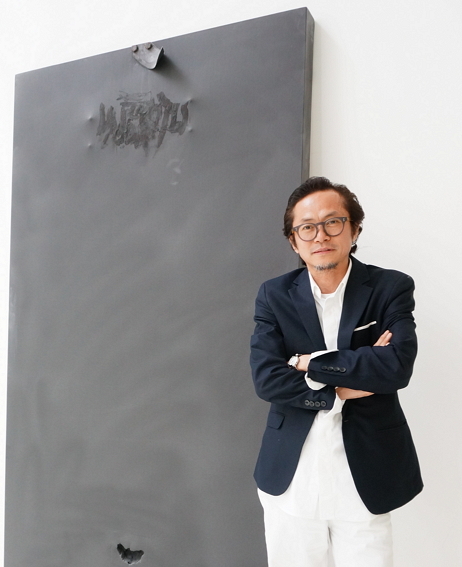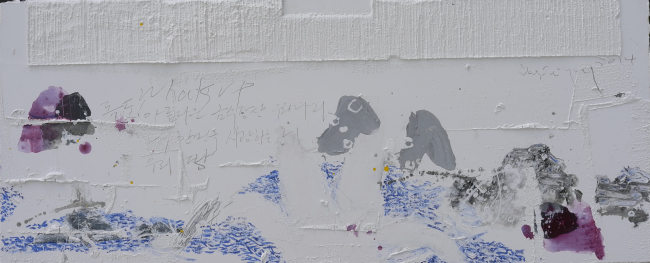[Herald Interview] Artistic endeavor to bridge gap on thorny issues
Korean artist Jeong Jai-young to exhibit abstract Dokdo-inspired paintings in Tokyo
By Lee Woo-youngPublished : May 18, 2014 - 20:35
Paintings inspired by the beauty of Korea’s easternmost islets of Dokdo will be on exhibit at the heart of Tokyo’s Ginza area in August. Given the tension between Korea and Japan over the sovereignty of the rocky islets, the exhibition seems a rather bold move.
The artist behind the daring attempt is Jeong Jai-young, 50, who has been painting abstract images of the islets for the last decade. Through his representative Lee Il-young, director of the Korea Art Center, a private gallery in Seoul, the artist has signed a contract with Ginza Koshin Gallery in Tokyo to showcase some 20 paintings under the title “Korea’s Nature ― Dokdo” from Aug. 11-17.
“Dokdo has been mired in political fighting between Korea and Japan. My exhibition is a different way of showing Koreans’ love for the islets as well as the universal value of the beautiful nature,” Jeong said in an interview with The Korea Herald at his studio in Busan last week.
“But despite the good intentions, holding an exhibition in Japan is a great challenge,” Jeong added.
The artist behind the daring attempt is Jeong Jai-young, 50, who has been painting abstract images of the islets for the last decade. Through his representative Lee Il-young, director of the Korea Art Center, a private gallery in Seoul, the artist has signed a contract with Ginza Koshin Gallery in Tokyo to showcase some 20 paintings under the title “Korea’s Nature ― Dokdo” from Aug. 11-17.
“Dokdo has been mired in political fighting between Korea and Japan. My exhibition is a different way of showing Koreans’ love for the islets as well as the universal value of the beautiful nature,” Jeong said in an interview with The Korea Herald at his studio in Busan last week.
“But despite the good intentions, holding an exhibition in Japan is a great challenge,” Jeong added.

Other Dokdo exhibitions planned to be held in Japan by Korean artists were canceled amid threats by Japanese right-wing groups. In 2008, artist Lee Jong-sang’s Dokdo paintings were pulled from a hotel art fair in Tokyo after the hotel decided not to showcase his paintings following several threatening calls.
A garden designer, whose Dokdo-themed miniature garden was on exhibit in London earlier this year, was requested by exhibition organizers to change the title of her garden after an anonymous call to drop the exhibition.
Jeong said he doesn’t want his works to be viewed as politically motivated art, but as an expression of “his love for the nature” or affection for the easternmost islets of Dokdo.
Unlike other compatriot artists who paint the Dokdo Islets as they are, Jeong bases his paintings on his personal feelings about the islets. He asserts that Dokdo is not only a beautiful place but also a place that should be respected for its own beauty.
“If I had thought of Dokdo as a potential site for natural gas reserves, I would have been too scared to paint a single image,” he said.
He hopes the beauty can be shared with the Japanese so that the strained relations between Korea and Japan will improve.
“Japan is geographically one of the closest countries to Korea. Things between us should be in harmony. I don’t want (the islets of) Dokdo to be at the center of a political dispute, but I want them to be the subject of beauty and love,” he said.

Jeong expresses his positive feelings about Dokdo in abstract, refined compositions. In one of his Dokdo paintings, he has positioned a small image of the islets in a bottom corner. The rest of the canvas is filled with his signature abstract scribbles, color blocks and paint applied thickly on the edge.
His Dokdo paintings contain key features of his painting style.
The different textures of his paintings can be traced back to his interest in the eternal nature of rocks since the 1990s. Spontaneity is observed in pencil scribbles, which started as part of his writing habit and later moved onto canvas in his sophomore year in college.
Born in the rural town of Yecheon, North Gyeongsang Province, a town said to be strongly influenced by Confucianism, he said the underlying spirit of his paintings lies in Confucian values. Although not apparent in his paintings, Jeong practices calligraphy every day to keep this spirit alive in his works.
Throughout his career, Jeong has also attempted to challenge established styles of art with radical experiments.
A progressive work that might be suitable for biennale exhibitions was shown in a private gallery space. Jeong stacked hundreds of wooden boxes used to contain fish that he bought at 50 cents at a local fish market and sprayed Paco Rabanne perfume on them to cover up the fishy smell.
In a gallery, he exhibited a pile of logs with wild butterflies, caterpillars and mosquitoes hidden inside them.
Jeong plans a worldwide exhibition to show that his works advocate peace.
He seeks to exhibit artworks which harmoniously combine different languages and cultures at a gallery in the U.N. headquarters in New York during the latter half of 2015 and to run the show until 2016.
By Lee Woo-young (wylee@heraldcorp.com)

















![[KH Explains] Hyundai's full hybrid edge to pay off amid slow transition to pure EVs](http://res.heraldm.com/phpwas/restmb_idxmake.php?idx=652&simg=/content/image/2024/04/18/20240418050645_0.jpg&u=20240418181020)

![[Today’s K-pop] Zico drops snippet of collaboration with Jennie](http://res.heraldm.com/phpwas/restmb_idxmake.php?idx=642&simg=/content/image/2024/04/18/20240418050702_0.jpg&u=)